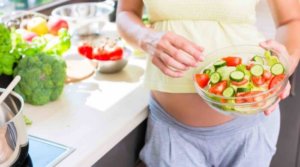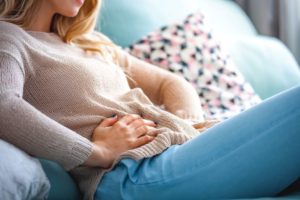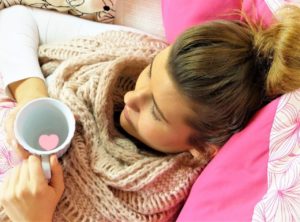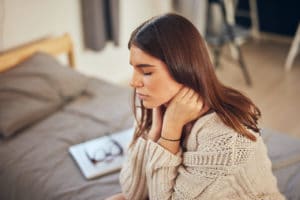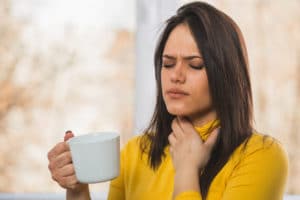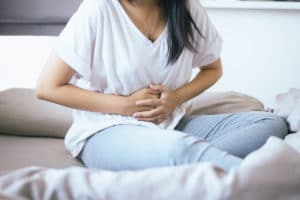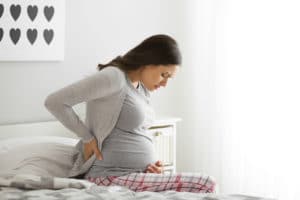Middle pain is experienced by affected women as a weakened variant of menstrual cramps. It manifests itself with a stabbing or pulling sensation in the abdomen and indicates ovulation.
When does abdominal pain occur without a period? Here, affected women agree: the mittelschmerz comes 14 days before the next period.
Table of contents
What Is Mittelschmerz?
The mittelschmerz is also known as ovulation pain and intermenstrual pain. There is a very simple reason for this, which relates to the timing of the pain (left lower abdomen, sometimes right lower abdomen or complete abdomen).
About one-third of all women of childbearing age feel the half-cycle abdominal pain without a period. In rare cases, the pulling in the abdomen may also be accompanied by light spotting or a larger amount of mucus.
There is little reason for concern, as the pain is directly related to pain during ovulation. As suddenly as the pulling occurs, the mittelschmerz is also quickly a thing of the past.
Why Middle Pain If The Pain Does Not Always Occur In The Middle?
This is a perfectly valid question that answers itself from a different perspective. Most women think of the term mittelschmerz as pain that occurs in the middle of the abdomen. But the term refers to the timing rather than the location where the pulling in the abdomen is noticed.
You suffer from pain left lower abdomen monthly and have already considered whether everything is okay health-wise? If the pain does not last longer than 24 hours and returns monthly in the middle of the cycle, you can be sure that you are simply ovulating.
It is a misconception that mid-cycle pain means a pulling or stabbing sensation in the middle of your abdomen. However, this theory is still valid.
Pain In The Left Lower Abdomen As An Indication Of Ovulation
When does ovulation occur? One-third of all women feel it. It manifests itself as pulling in the lower abdomen, can be felt as pain in the left lower abdomen, or can also be perceived as stabbing. Ovulation pain does not have to be felt every month.
Sometimes several periods go by without you feeling the pain. If you want to know more about ovulation, when exactly it is for you, you only need to listen to your body.
The midline pain will tell you between two days before and two days after ovulation when your fertile days are. If you also notice an increased temperature and other symptoms, you can be sure that you are ovulating.
Does Mittelschmerz Feel The Same In All Women?
The basic answer is no. The mittelschmerz can be felt as a slight pulling sensation in the abdomen. Some women have pain (left lower abdomen) that is not really different from menstrual pain.
You may have very mild or pulling pain in your lower abdomen. Your work colleague or girlfriend, on the other hand, does not notice the fertile days at all. It is a fact that especially sensitive women feel the mittelschmerz and perceive it in different degrees and strengths.
How you feel the mittelschmerz also depends on your personal sensitivity and pain perception. For most women it is rather a discomfort for which the term pain is not used at all.
Ovulation: When Is The Pulling In The Abdomen Strongest – Before Or After?
For some women it is before ovulation, for others, it is after ovulation or directly at the moment of ovulation. The pain shows you not only the fertile days but also the side of ovulation. If the pain left the lower abdomen is clearly noticeable, you will usually have ovulation in the left ovary.
There are also different causes for middle pain. Some women feel the growing egg in the tissue, which can cause abdominal pain without a period. Other women feel the follicle bursting, and some women notice the ovaries contracting after ovulation.
Middle Pain Or A Problem With The Ovaries?
The difference is not always obvious. If pain (left lower abdomen) refuses to end or increases over a period of two to three days, there may be inflammation of the ovaries.
On the other hand, a slight pulling in the abdomen that is no longer felt on the following day need not frighten you. This is usually the middle pain, especially if the time fits perfectly with your ovulation. If you are unsure, you can bring up the problem at your next gynecologist’s visit and get reassurance.
Do Only Fertile Women Have Pain In The Lower Abdomen?
In order to answer the question, the generality must be taken out of the statement. Only women who are not yet in menopause have pain in the middle, i.e. the pain during ovulation. This is because the pulling in the abdomen caused by ovulation presupposes that ovulation is taking place.
However, even if you have a normal menstrual period, you may not ovulate. Have you been trying to get pregnant for a long time and it doesn’t work? Then observe your body closely in the next mid-cycle. If nothing happens at all, the lack of ovulation could be a reason for the childlessness.
When You Want To Have Children, The Time Of The Midcycle Is Important
When it comes to the desire to have children, the middle of the month is crucial. Here you have a clear advantage if you feel the pain in the abdomen clearly and yet not too strongly. When you feel a pulling sensation, it is the right time for a romantic evening with your partner.
There is no surer indication of ovulation than the feeling that women with intermenstrual pain experience about 14 days before their next period. Since the pain in the lower abdomen is usually of a minor and not really painful nature, nothing stands in the way of your desire to have a child when planning your fertile days.
Why Does Ovulation Hurt?
The tissue around the egg grows and tightens. This can lead to a pulling or stinging sensation and can be experienced more or less as pain. The bursting of the follicle and the release of the egg also cause irritation in some women.
If the fallopian tubes contract again after your fertile days, this circumstance can also be experienced as an unpleasant pulling sensation in the abdomen. Hand on heart: it’s not really pain, but more of a discomfort that is accompanied by a slight to moderate pulling or stinging sensation.
What Can Be Done About The Middle Pain?
The same tips apply here as for period pain. Allow yourself to rest, relax and avoid strenuous tasks. If the pain (left lower abdomen) is causing you a lot of discomfort, you should see a doctor and not use painkillers to get through the day.
Normally, warm teas, and a warm bath, a hot water bottle, or simply a little more rest than usual will help. Do not get stressed, because stress increases blood pressure and increases blood flow to your ovaries. In this case, the middle pain would increase.
Pain In The Lower Abdomen Does Not Always Announce Your Period
Do you know the caution of going out of the house with only a liner on, even though your period is not even on yet? The phenomenon is quite common among women with severe mid-menstrual pain.
Even if the abdominal pain comes without a period, you may experience light spotting or increased secretion. If you write down your cycle, which you should definitely do, you will know exactly on which day the pulling in the abdomen catches up with you. There are still 11 to 14 days between the middle pain and the next menstruation. So relax.
Abdominal Pain Without A Period: Will It Go Away After Pregnancy?
You have been dealing with menstrual cramps since your youth. In recent years, your ovulation has also become more and more painful. There is no cure for period pain except rest and warmth.
Middle pain, on the other hand, is not a condition that necessarily accompanies you until menopause. Most of the affected women notice during their periods after pregnancy that the pulling in the abdomen does not return.
There is no scientific explanation for this sensation. But the experiences of other women are clear in answering this question and give you hope.
What Is The Difference Between Mittelschmerz And Menstrual Pain?
For most women, the difference is already expressed in the intensity of the pain. Middle pain is more of pulling in the abdomen, while menstrual pain is much more intense. In very few cases, mid-cycle pain in the abdomen will present with nausea, headache, or even vomiting.
This is quite different with severe menstrual cramps. A serious difference is the fact that the abdominal pain occurs without a period and only extremely rarely entails a light spotting.
What Are The Causes Of Mid-menstrual Pain?
Women who feel a pulling in the lower abdomen every month as a middle pain deal calmly with this indication of their ovulation. However, if the pain occurs for the first time or is very severe, the concern may be well-founded. An appointment with a gynecologist, to whom you report the problem in detail, provides certainty.
During the examination and a smear test, he will determine whether you are suffering from inflammation. If no cause for the pulling in the abdomen is found and the timing fits the mid-cycle, you can almost certainly assume that you have mid-cycle pain.
Mid-cycle Pain Can Also Indicate Endometriosis
Do you suffer from the period and mid-cycle pain that is really severe? Do you have an irregular cycle and very heavy or very long menstruation? Then medical advice is important. In the case of endometriosis, a benign growth of the lining of your uterus, all the pains associated with the menstrual cycle are very severe.
A sure sign is also pain during sex or afterwards. In most cases, without mechanical influence, the pain “only” occurs during menstruation and in the middle of the cycle. But severe endometriosis can cause the pain in the lower abdomen to be permanent or very frequent.
When To Go To The Doctor With Mid-cycle Pain?
The best time to see a gynecologist is when you are not sure of the cause of your pain. When was ovulation again? A look at the cycle calendar will tell you. On the other hand, you cannot diagnose inflammation of the ovaries or uterus yourself.
Pain (left lower abdomen, middle or right side) can always be a sign of inflammation. Those who still have their appendix should keep a special eye on the intensity of the pain.
Initially, appendicitis is no different from a pulling sensation in the lower abdomen. But within a few hours, the pain increases dramatically. In the case of mittelschmerz, the course is reversed and the pain decreases.
Middle Pain Is Usually Not A Cause For Concern
During your period, you see the pain as something completely normal. Even in the middle of the cycle, a pulling sensation in the abdomen is not unusual. Only if it is a real pain with increasing severity or longer duration, a visit to the gynecologist may be advisable.
By looking at your menstrual calendar, the doctor can see at first glance if he or she can rule out mittelschmerz. You do not have to be ashamed, even if you went to the doctor “for nothing”. Women who suffer for the first time or from a strong mittelschmerz are more likely to suspect an inflammation behind it than an accompanying symptom of ovulation.
Heavy Discharge In The Middle Of The Cycle And Pulling In The Abdomen
In addition to a stabbing or pulling pain, increased discharge is also an accompanying symptom of ovulation. Here, practice shows that the discharge increases as the pulling increases. If your pain (left lower abdomen, for example) is mild, you will normally have only a small discharge.
If your abdomen hurts a lot, the discharge can be so strong that you should not leave the house without a pad. Note: The discharge is clear and odorless. If you notice something different, it may be an infection that is causing the pain and discharge.
In this case, you should not wait long to visit the gynecologist and ask if you can come directly to the office without an appointment.

